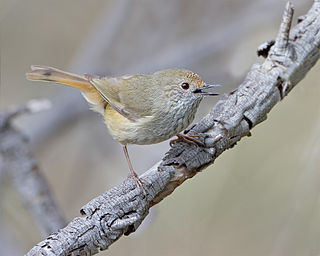
The semipalmated sandpiper is a very small shorebird. The genus name is from Ancient Greek kalidris or skalidris, a term used by Aristotle for some grey-coloured waterside birds. The specific pusilla is Latin for "very small".

Baillon's crake, also known as the marsh crake, is a small waterbird of the family Rallidae.

The field sparrow is a small New World sparrow in the family Passerellidae. It is about 140 mm (6 in) long and weighs about 12.5 g (0.4 oz). The head is grey with a rust-coloured crown, white eye-ring and pink bill. The upper parts are brown streaked with black and buff, the breast is buff, the belly is white and the tail is forked. There are two different colour morphs, one being greyer and the other more rufous.

The brown thornbill is a passerine bird usually found in eastern and south-eastern Australia, including Tasmania. It can grow up to 10 cm (3.9 in) long, and feeds on insects. It is brown, grey and white. The species has five subspecies.
The least big-eared bat is a bat species of the family Phyllostomidae, found in northwestern Brazil and eastern Colombia. It is the only species within its genus.

The southern little yellow-eared bat is a frugivorous bat species found in Brazil, Argentina and Paraguay.

Hemilophini is a tribe of longhorn beetles of the subfamily Lamiinae.
Eranina is a genus of longhorn beetles of the subfamily Lamiinae, containing the following species:
Eranina costaricensis is a species of beetle in the family Cerambycidae. It was described by Galileo and Martins in 2005. It is known from Costa Rica.
Eranina flaviventris is a species of beetle in the family Cerambycidae. It was described by Galileo and Martins in 2005. It is known from Honduras.
Eranina nigrita is a species of beetle in the family Cerambycidae. It was described by Galileo and Martins in 1991. It is known from Brazil.
Eranina moysesi is a species of beetle in the family Cerambycidae. It was described by Galileo and Martins in 2008. It is known from Costa Rica.
Eranina rondonia is a species of beetle in the family Cerambycidae. It was described by Galileo and Martins in 2008. It is known from Brazil.
Eranina piterpe is a species of beetle in the family Cerambycidae. It was described by Galileo and Martins in 2007. It is known from Bolivia.
Eranina tauaira is a species of beetle in the family Cerambycidae. It was described by Martins and Galileo in 1993. It is known from Colombia.
Eranina pectoralis is a species of beetle in the family Cerambycidae. It was described by Henry Walter Bates in 1881. It is known from Guatemala and Mexico.
Eranina univittata is a species of beetle in the family Cerambycidae. It was described by Bates in 1881. It is known from Mexico.
Eranina cincticornis is a species of beetle in the family Cerambycidae. It was described by Bates in 1866.
Eranina fuliginella is a species of beetle in the family Cerambycidae. It was described by Bates in 1885. It is known from Guatemala.
Eranina ciliata is a species of beetle in the family Cerambycidae. It was described by Fisher in 1938.





